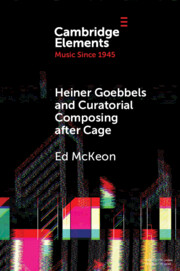Element contents
Heiner Goebbels and Curatorial Composing after Cage
Published online by Cambridge University Press: 28 October 2022
Summary
- Type
- Element
- Information
- Series: Elements in Music since 1945Online ISBN: 9781009337618Publisher: Cambridge University PressPrint publication: 24 November 2022

